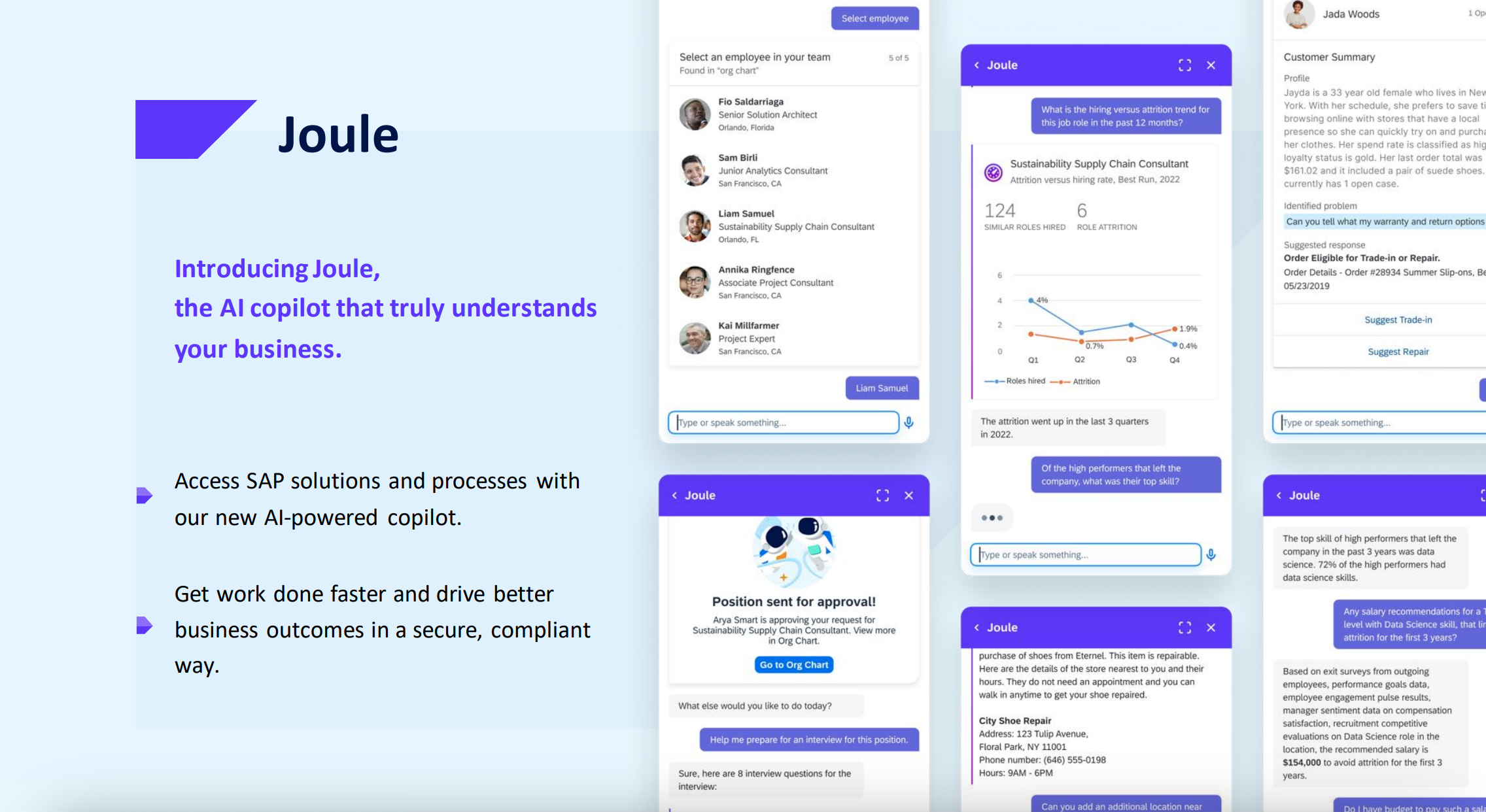Is SAP's AI Fog Clearing?
Insights from Dr Philipp Herzig's Executive Session
Understanding SAP’s AI Vision
In a recent executive session hosted by the SAUG, Dr Philipp Herzig, SAP’s Chief AI Officer, shared insights into SAP’s emerging AI strategy. This virtual event, attended by members of the SAUG Executive Council, aimed to shed a bright light on SAP’s AI strategy, initiatives and their potential impact on members' businesses.
Embracing the AI Revolution
Dr Herzig began by highlighting the global transformative potential of AI on businesses and economies. He predicted a staggering $4.1 trillion economic impact within the next three years.
This figure, comparable to the GDP of Germany, underscores the significant role AI will play in reshaping industries and business operations and its massive strategic importance for SAP.
Key Highlights from SAP's AI Portfolio
Generative AI: A New Era of Productivity
Generative AI, Dr. Herzig explained, is revolutionizing productivity by automating content creation. Things which traditionally took months or weeks, can now be accomplished in minutes or seconds.
This shift is being driven by the advent of large pre-trained models (LLM's like ChatGPT), enabling practical AI applications for everyone.
Dr Herzig noted that the marginal cost of content creation has dramatically decreased. For context, he compared this with previous technological shifts like the reduction in distribution costs brought by the internet and computing costs lowered by microchips.
This democratisation of AI capabilities allows businesses of all sizes to leverage powerful AI tools that were previously accessible only to the largest of enterprises.
SAP's AI Achievements
Herzig claims that SAP's AI solutions are already making waves, with over 27,000 customers leveraging various AI scenarios monthly. He described key successes including:
- Supply Chain Management: Visual Inspection and intelligent goods receipt analysis, improving accuracy and speed in logistics operations.
- Procurement: Content recommendations in SAP Ariba Category Management, enhancing decision making in supply chain management.
- Finance: Faster itemisation of hotel receipts in SAP Concur and enhanced document information extraction, reducing manual data entry and processing time.
These examples do show how AI can be used streamline traditional operations, enhance decision making, and further improve overall business efficiency.
The Joule AI Co-Pilot
One of the standout innovations he drew our attention to is Joule, SAP's AI-powered co-pilot.

Joule is designed to understand business contexts with a view to streamlining workflows and enhancing user productivity across SAP applications. Some key capabilities of Joule include:
- Intelligent Email Drafting: Generating context-aware emails that can be refined for tone and detail, saving significant time for users.
- Transaction Processing: Automating routine tasks such as invoice processing and payment release, thereby reducing manual intervention and errors.
- Enhanced User Interaction: Integrating with various SAP applications to provide a seamless and intuitive user experience.
Joule's ability to integrate across SAP's ecosystem ensures that users have a consistent and efficient experience, regardless of the specific application they are using.
Dr Herzig even envisions a future where user menus and transaction codes (T-codes) are obsolete. He predicts that AI-driven interfaces may replace traditional navigation methods, streamlining how users interact with SAP systems. This shift, he believes could mark the end of T-codes, which have been the primary navigation tool in SAP systems for nearly 50 years.
Leveraging External Large Language Models
A notable aspect of SAP's AI strategy is its decision not to build its own large language model (LLM).
This approach seems somewhat unusual for SAP, which traditionally has liked to develop such technologies in-house. Instead, SAP has chosen to leverage the best external (non-SAP) LLMs for each specific purpose.
Dr Herzig explained that this strategic decision allows SAP to tap into the latest advancements in AI without the need for extensive internal development efforts.

By partnering with multiple external LLM and AI providers, SAP can ensure that its solutions are always utilising the most effective and cutting-edge technologies available. These external LLMs are integrated into SAP's Business Technology Platform (BTP), creating a shared AI framework that spans the entire SAP solution portfolio.
This integration enables a cohesive and powerful AI ecosystem that benefits from the strengths of various LLM providers.
Narrow AI vs Broader AI Scenarios
Dr Herzig emphasised the distinction between "narrow AI" scenarios and broader AI applications. Narrow AI refers to the highly specific, pre-defined use cases that SAP currently offers across its product portfolio.
These include automated reconciliation in finance, enhanced forecasting in supply chain management, and job description generation in HR. These scenarios are designed to deliver immediate, tangible benefits and are relatively straightforward to implement.
In contrast, broader AI scenarios involve leveraging SAP's AI tools to extend existing applications or build entirely new solutions tailored to an organisation's unique needs. Dr Herzig highlighted how SAP provides the foundational tools and platforms, such as SAP BTP, to enable customers to create custom AI applications. This approach empowers organisations to innovate and adapt AI technologies to their specific business contexts.
However, this strategy raises some critical questions. While it offers fantastic opportunities for organisations with a clear vision and the technical expertise to develop bespoke AI solutions, it also suggests that SAP may be abdicating some responsibility for envisioning and designing future business practices powered by AI. This approach places the onus on customers to identify and develop their own AI use cases, which might be challenging for organisations that lack clarity or expertise in AI.
Relevant, Reliable and Responsible AI
SAP's AI strategy is built on three pillars: relevance, reliability, and responsibility.
Relevant: AI solutions are embedded within business processes, enhancing their relevance and ease of use. This ensures that AI tools directly contribute to business objectives and user productivity.
Reliable: SAP partners with various large language model providers to ensure the best performance and cost efficiency. The AI foundation on SAP's Business Technology Platform (BTP) ensures secure, private, and reliable AI operations. By utilising the best available models, SAP ensures that their AI solutions are robust and dependable.
Responsible: SAP adheres to strict ethical guidelines, ensuring transparency, bias mitigation, and human oversight in AI deployment. This commitment includes an AI Ethics Advisory Panel and comprehensive governance to ensure AI is used in a manner that benefits society and avoids harm.
Real-World Applications and Case Studies
Dr Herzig shared several practical examples where SAP's AI solutions are driving significant business value:
- Finance: Automated reconciliation and cash processing have increased accuracy and speed. Companies like Chobani, he says, have significantly reduced the time spent on expense management through AI-driven automation.
- Supply Chain: Enhanced forecasting capabilities in operational and demand planning have reduced planning cycles and improved accuracy for companies like CF Automotive, a large automotive supplier in Germany.
- HR: AI-driven job description generation and interview preparation in SAP SuccessFactors have improved the efficiency and effectiveness of recruitment processes.
Pragmatic Advice for SAUG Members
While SAP's AI vision is compelling, it's essential to maintain a pragmatic perspective. SAP's journey in the AI space is still in its early stages, and there may be changes and surprises along the way. Therefore, SAUG recommends members to:
- Broaden AI Strategies: Develop comprehensive AI plans that do not rely solely on SAP's solutions. Explore and integrate AI capabilities from multiple vendors to ensure flexibility and resilience in your AI strategy.
- Monitor SAP's Progress: Keep a close eye on SAP's developments and be prepared to adapt your AI strategies as SAP's offerings evolve. Regularly review SAP's AI updates and assess how they align with your business needs.
- Leverage Existing Tools: Utilise SAP's current AI tools where applicable to gain immediate benefits but remain open to incorporating other AI technologies that may offer complementary or superior functionalities.
- Engage with the Community: Participate in SAUG forums and discussions to share experiences and learn from other members' AI implementation journeys. This collaborative approach can provide valuable insights and help navigate the complexities of AI adoption.
- Focus on Data Quality: Ensure your organisation's data is clean, well-organised and readily-available for AI training and analysis. High-quality data is crucial for successful AI implementations, regardless of the platform used.
Summary and Conclusion
Dr Philipp Herzig's open and insightful session underscored both the potential and the challenges of SAP's evolving AI strategy. With ambitious goals and a clear emphasis on leveraging external large language models, SAP is positioning itself to capitalise on the transformative power of AI. However, the journey is still in its early stages, and the path forward may be fraught with adjustments and unforeseen changes.
For SAP users, this means a cautious but proactive approach is necessary. Broaden your AI strategies beyond SAP's current offerings, keep an eye on SAP's progress, and be prepared to adapt your plans as the landscape evolves. Engage with the SAUG community to share insights and experiences, ensuring that your AI implementations are informed by the collective wisdom of your peers.
Above all, focus on maintaining high data quality, as this will be the cornerstone of any successful AI initiative. By doing so, you can position your organisation to take full advantage of the benefits AI has to offer while navigating the uncertainties of this rapidly developing field.




